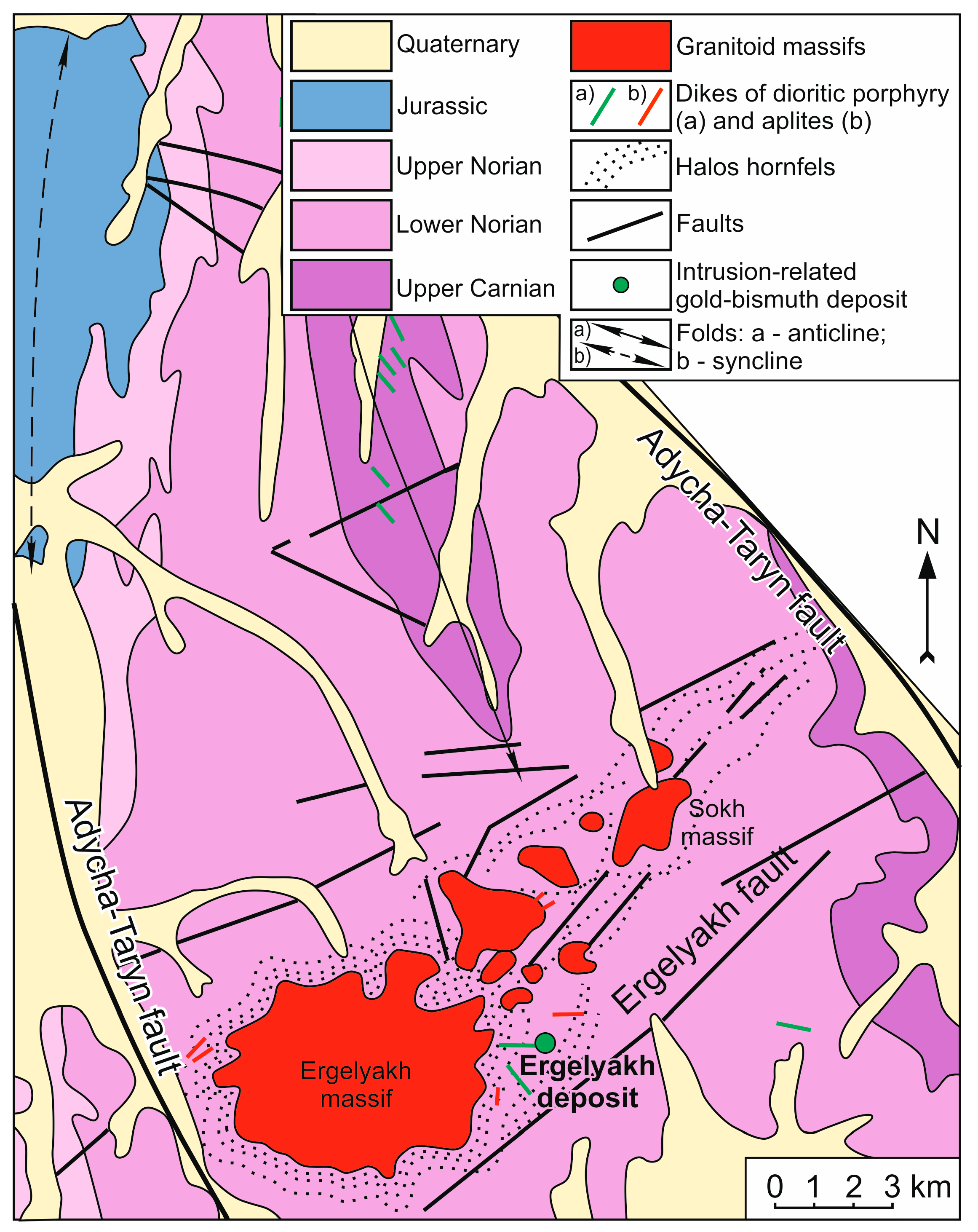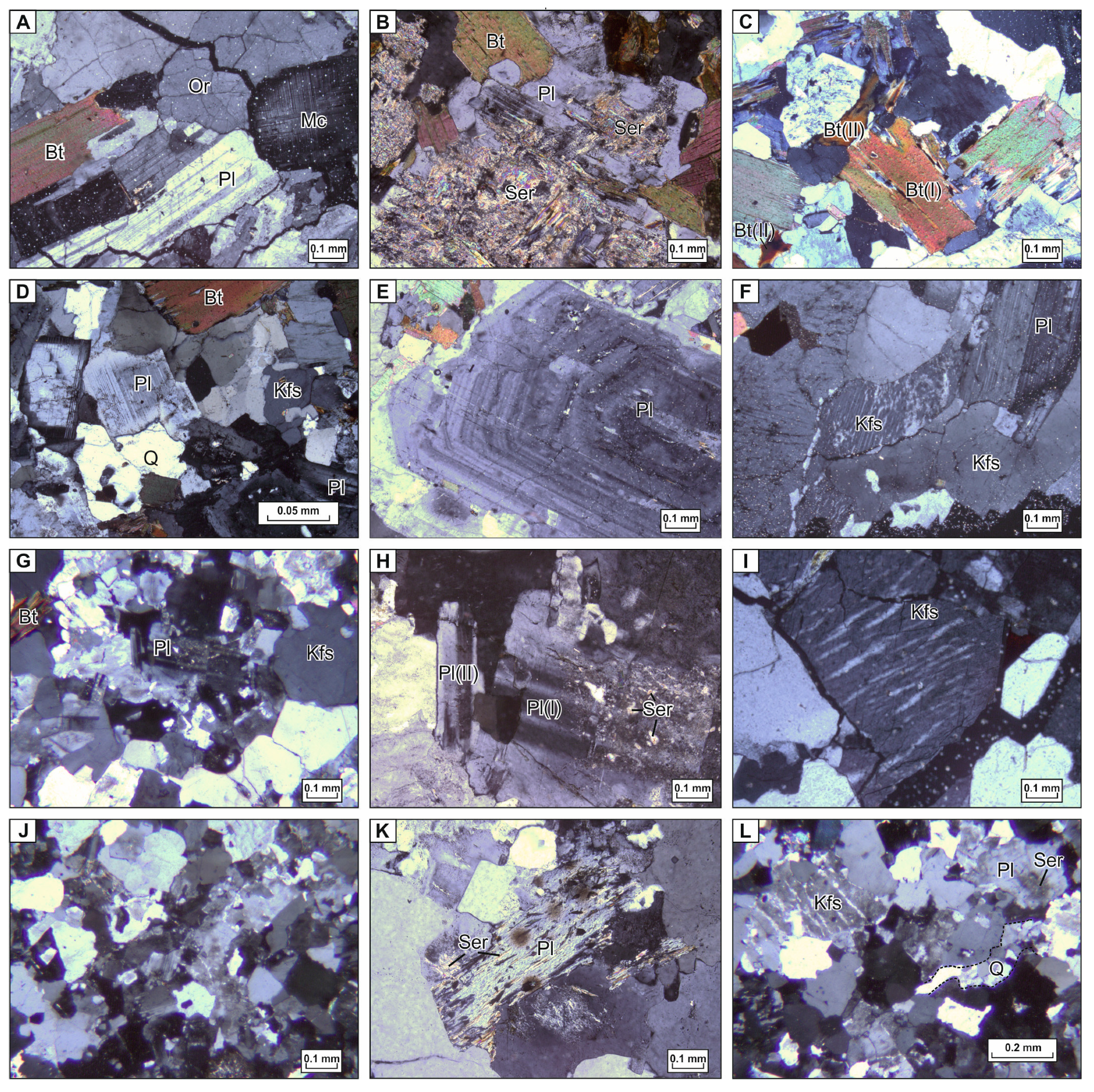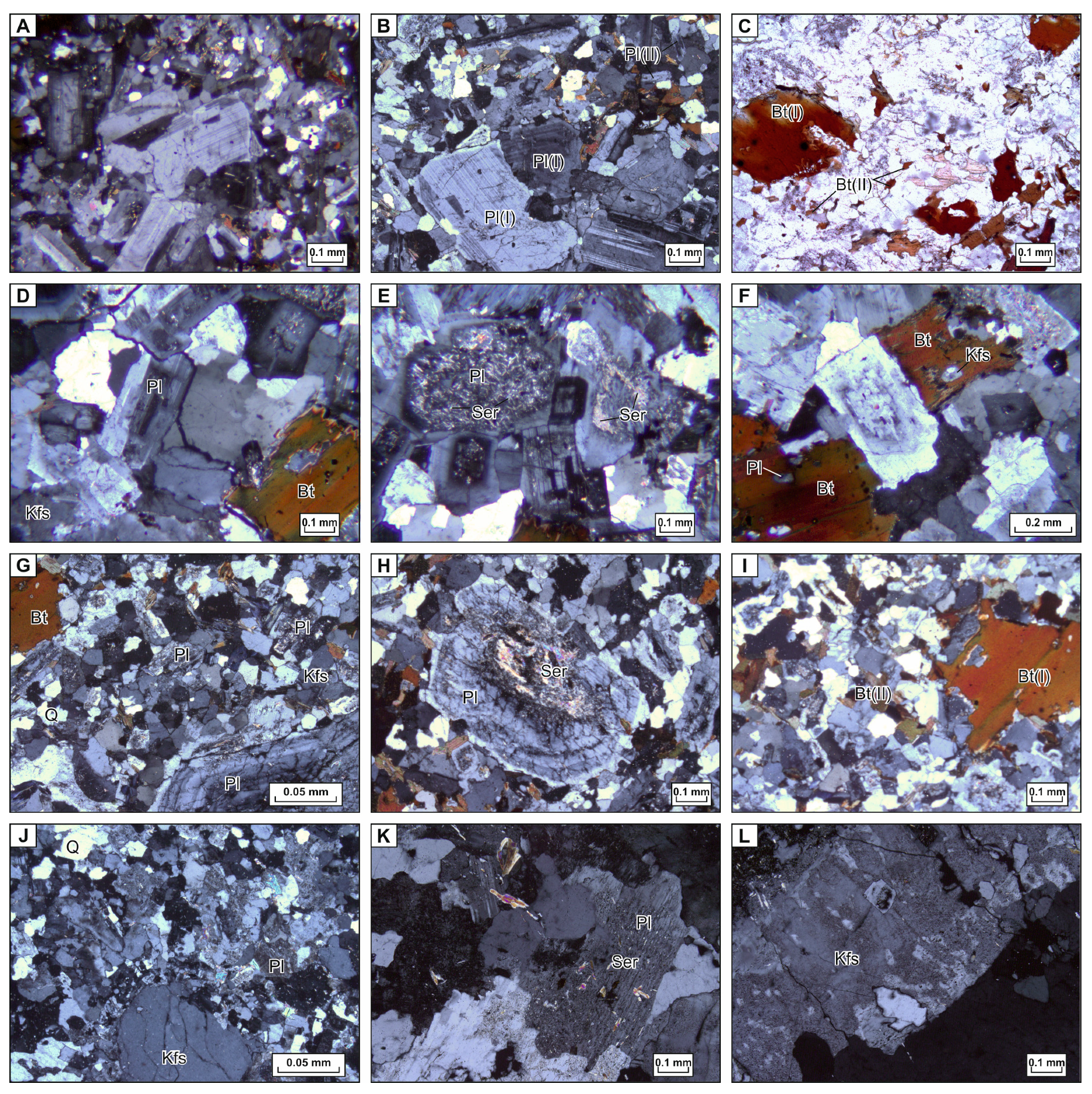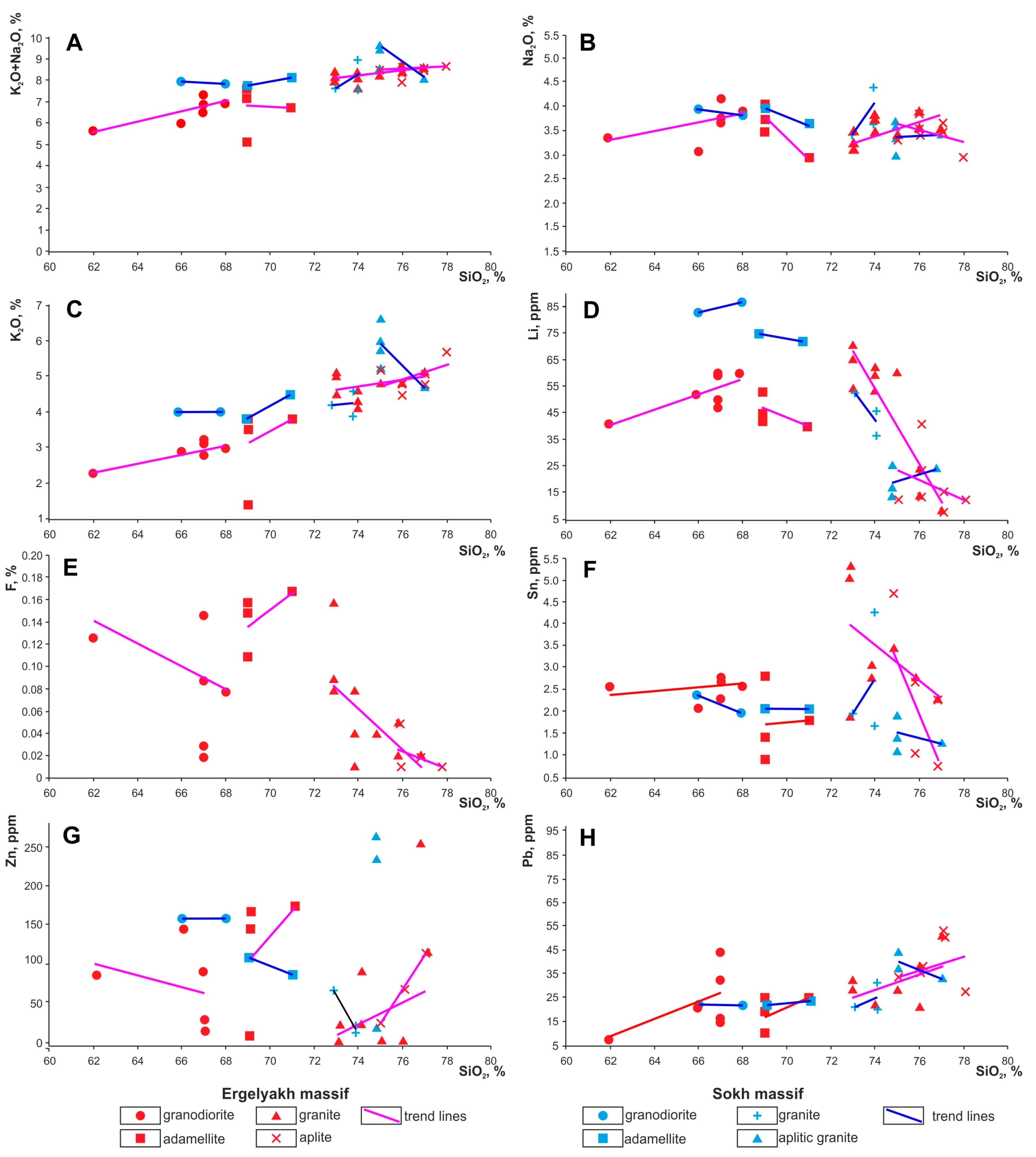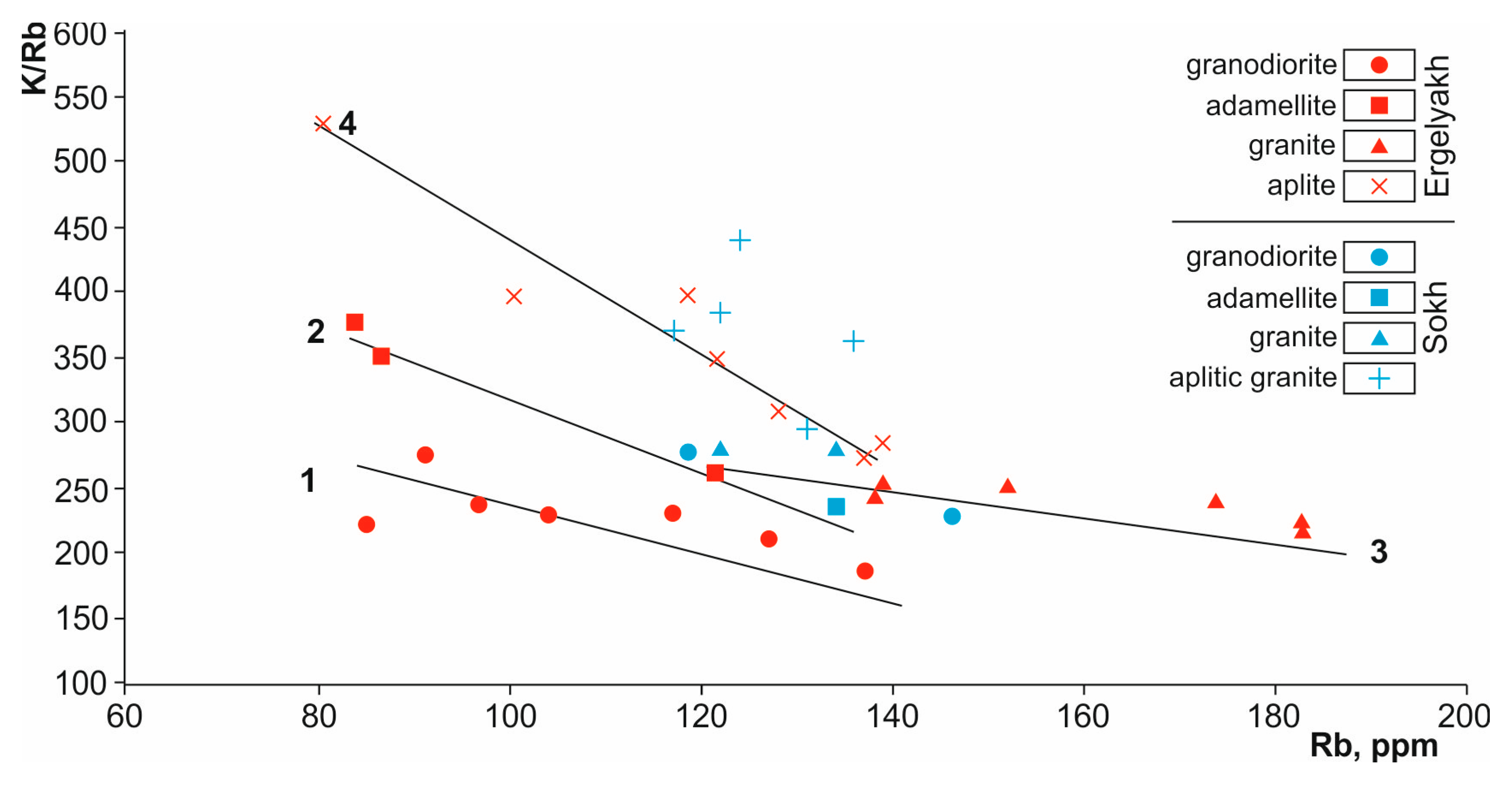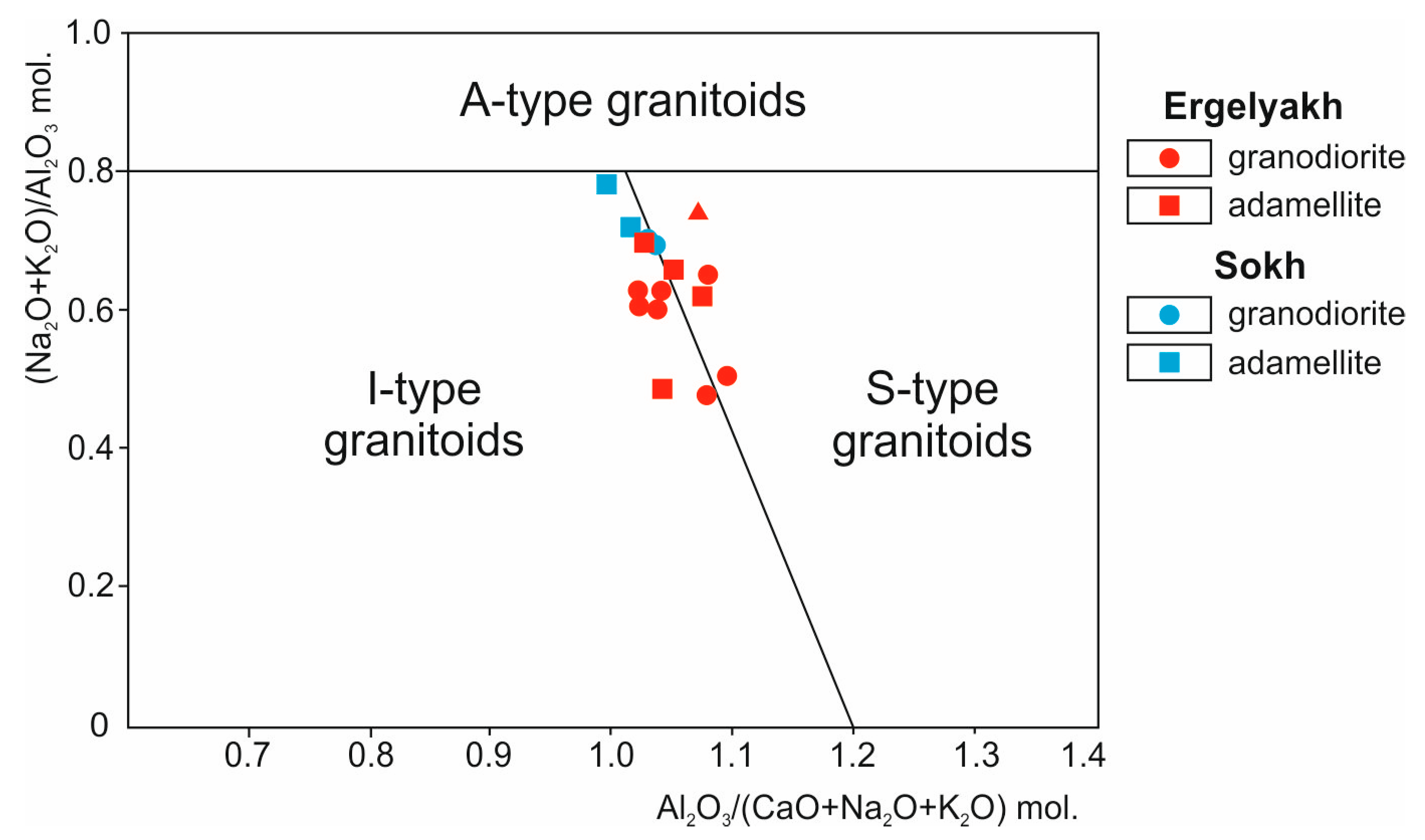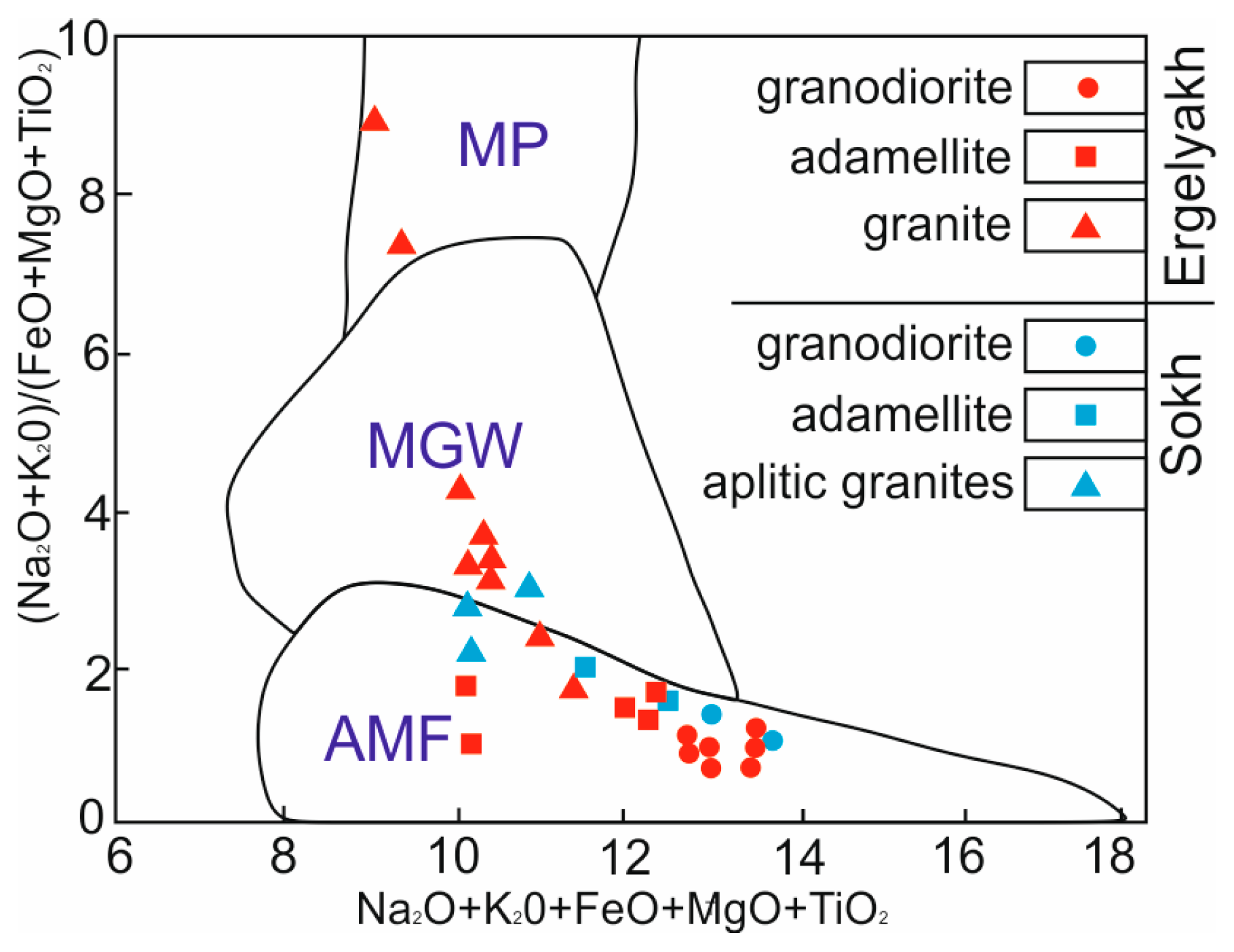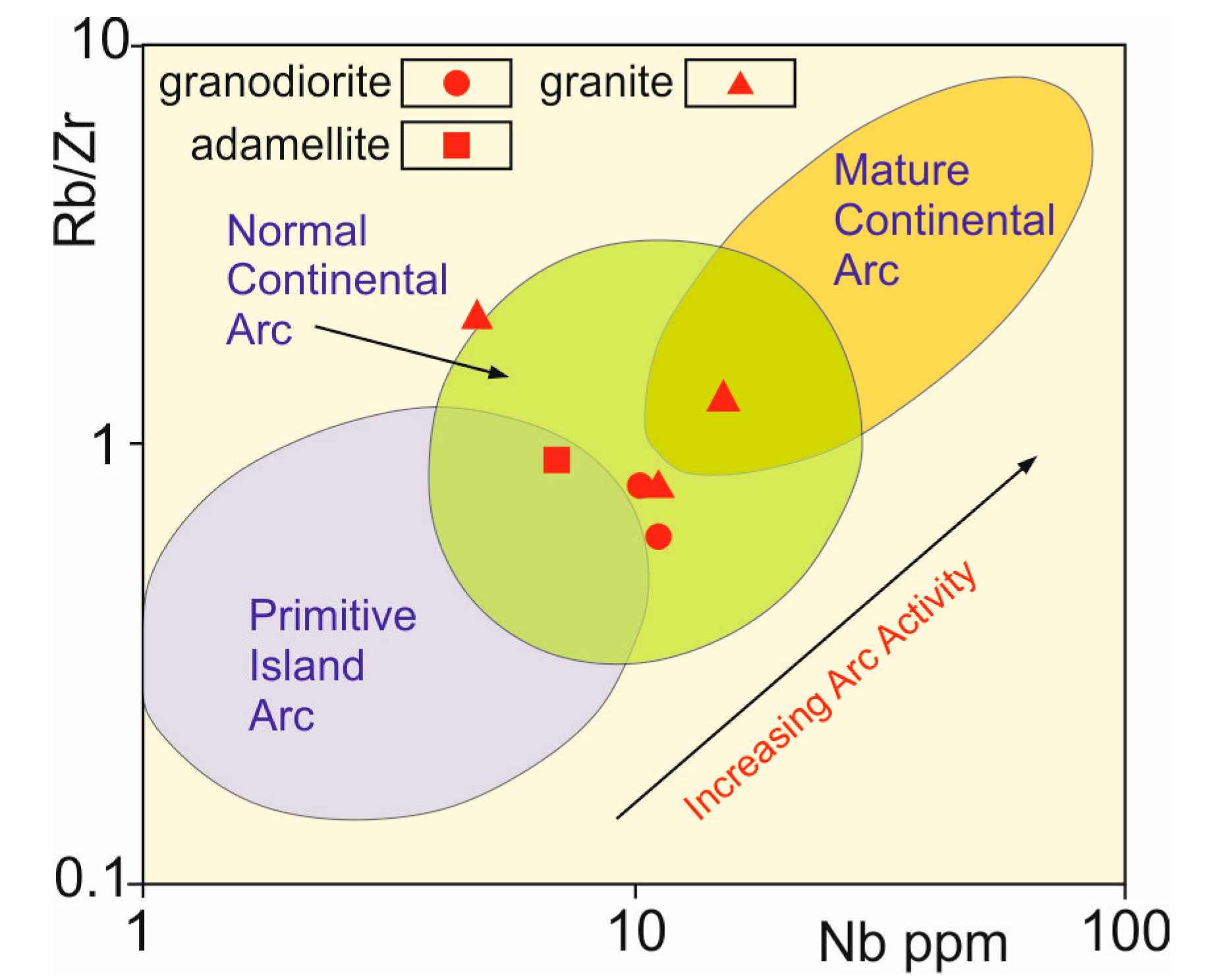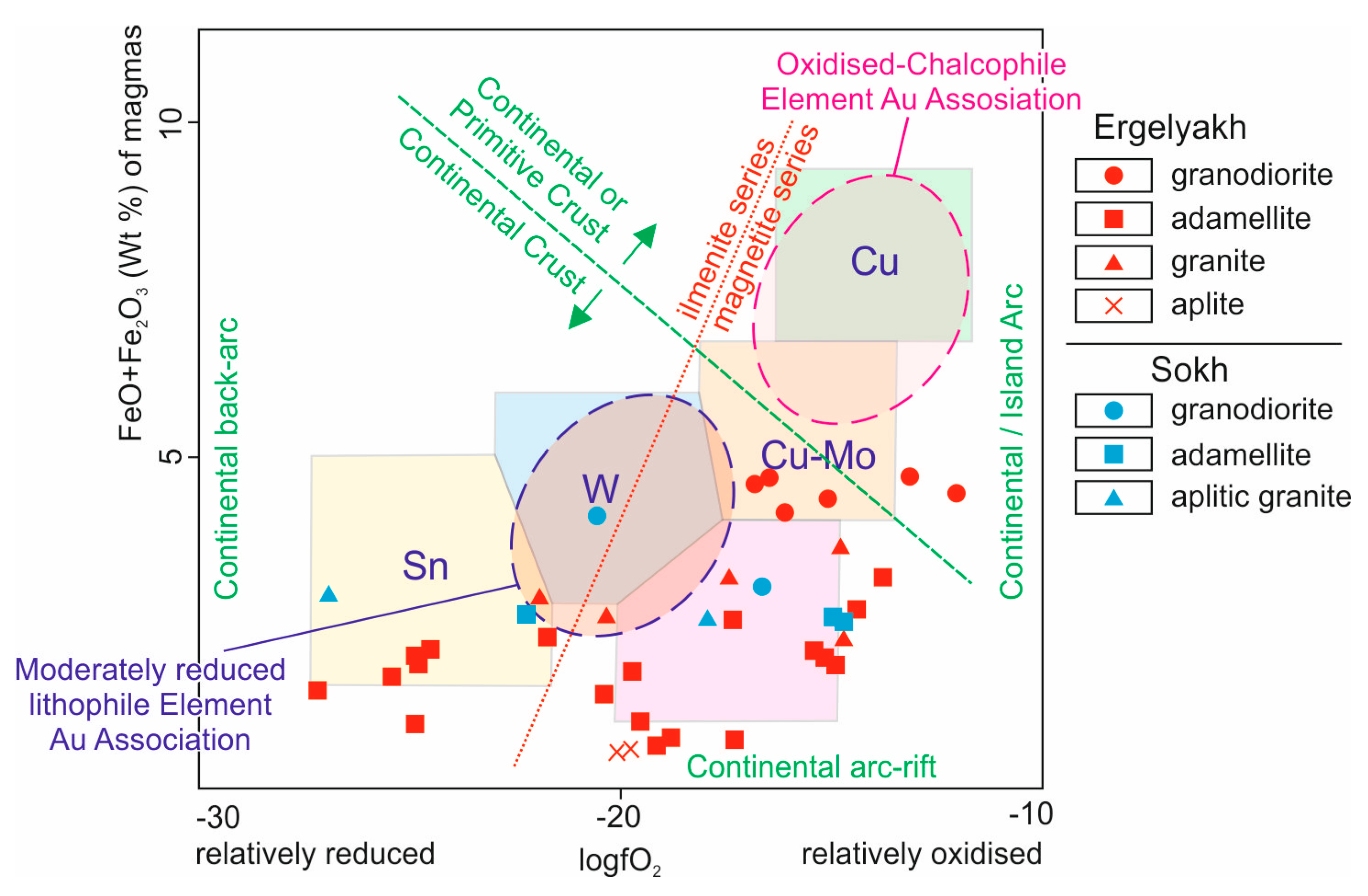4.1. Chemical Composition of Rock-Forming Minerals
The most informative rock-forming minerals of the studied massifs are K-feldspars, plagioclase, and biotite. In our study we paid special attention to them.
The data obtained show that K-feldspar in all granitoid types is characterized by wide variations in orthoclase (54.5–93.2%) and plagioclase (11.7–40.8%) components (
Table 1 and
Table 2). Plagioclase is high in orthoclase component (2.4–8.4%) irrespective of its basicity and the type of granitoids. The content of anorthite mineral in plagioclase ranges from 42.0% to 7.6%, i.e., from andesine to albite, indicating that formation of plagioclase from the EIRGD granitoids took a long time and occurred under nonequilibrium conditions. Chemically, it contains, on average, 25–33% anorthite and 4.6–6.3% orthoclase components.
Biotites from granitoids of the EIRGD (
Table 3) are mainly represented by Fe–biotite (Fe# = 0.57–0.95) except for two samples from granodiorites and one sample from adamellites of the Ergelyakh massif. The oxidation degree of Fe (Fe
3+/ƩFe) in biotites of the Ergelyakh massif varies from 0.05 to 0.30, and in those of the Sokh pluton from 0.05 to 0.22. Biotite is highly ferruginous (f = 75.7–93.6%) and aluminous (K
Al = 0.22–0.27).
The biotite in Sokh massif is moderately ferruginous (f = 57.4–60.7%) and high in alumina (KAl = 0.23). Chlorites, developed after mica, are represented by ripidolite. The degree of biotite chloritisation in granodiorites of the Ergelyakh massif is 15.0–4.7%; in adamellites, 11.4 ± 1.1%, and in granites, 9.7 ± 3.6%. For the Sokh massif, the values are 12.3 ± 0.3% in granodiorites, 10.7% in adamellites, and 9.0 ± 8.9% in granites.
4.2. Chemical Composition of Accessory Minerals
The principal accessory minerals of granitoids from the Ergelyakh and Sokh massifs are ilmenite, zircon, and apatite. Grains of orthite, anatase, fluorite, monazite, rutile, garnet, and sulfides (arsenopyrite, loellingite, pyrrhotite, pyrite, bismuth minerals, galena) are rare to solitary [
6].
Garnets from granitoids of both massifs are represented by almandine with varying amounts of spessartine, pyrope, andradite, grossular, and majorite. In the Ergelyakh massif, the quantity of almandine component in garnets (
Table 4) increases from granodiorites (76.2–80.9%) to granites (82.2–83.3%). The amount of andradite component also grows from 1.3–2.0% in granodiorites to 1.2–3.4% in granites. Most pronounced are changes in pyrope and spessartine components. The content of spessartine in garnets from granodiorites is 4.2–6.2%, and in garnets from granites is up to 9.6–11.2%. Pyrope in garnets sharply decreases from granodiorites (10.12–13.65%) to granites (2.01–3.0%). This is accompanied by decreasing Mg content (Mg#) of garnets from granodiorites (0.14–0.15) to granites (0.03–0.04) and by an increasing degree of iron oxidation (Fe
3+/ƩFe) from 1.6–1.9 to 3.6–4.2, respectively.
Garnets from the Sokh massif do not exhibit a distinct trend in composition. The amount of almandine in garnets from granitoids (
Table 4) varies within a narrow range (69.7–78.2%). Garnets from adamellites are somewhat higher in almandine (70.8–78.2%) and those from granodiorites and aplitic granites have lower almandine content: 71.7–72.9% and 69.7–71.8%, respectively. A more pronounced trend is observed for spessartine in garnets, which is high in granodiorite porphyries and aplitic granites (24.6–25.6%) and low in adamellites (1.7–5.5%). Garnets from adamellites are also marked by elevated pyrope mineral content (13.5–22.0%), which is much higher than in granodiorites and aplitic granites (0.4%). This promotes differences in Mg# value, which is higher in garnets from adamellites (0.02–0.23) than from granodiorites and aplitic granites (0.03–0.14). Garnets from adamellites also exhibit a higher degree of iron oxidation (Fe
3+/ƩFe = 1.2–2.6) as compared to granodiorites and aplitic granites, which is zero. These differences in the composition of garnets are due to different conditions of their formation.
4.3. Petro- and Geochemical Composition of Granitoids of Ergelyakh and Sokh Massifs
Granitoids of both massifs belong to the alkaline series due to their high-K variety (
Table 5). They contain moderate amounts of alumina (ASI for the Ergelyakh massif is 1.0–1.2 and for the Sokh massif is 1.0–1.1). In terms of petrographic and petrochemical data, the rocks of both massifs correspond to the granodiorite–granite complex. They have similar petrochemical composition (
Table 5) but differ in the number of alkaline elements. Granodiorite porphyries and adamellites of the Sokh massif characteristically have a higher K
2O + Na
2O sum (7.9 ± 0.4% and 7.9 ± 0.2%, respectively) in contrast to the same rocks from the Ergelyakh massif (6.6 ± 0.6% and 7.0 ± 1.0%) (
Figure 5A). They are rather close in Na
2O content (3.9 ± 0.1 and 3.8 ± 0.2 in the Sokh and 3.6 ± 0.3 and 3.5 ± 0.6 in the Ergelyakh, respectively) but differ drastically in K
2O quantity (
Figure 5B,C). In granodiorite porphyries and adamellites of the Sokh massif, K
2O content is equal to 4.0 ± 0.02% and 4.1 ± 0.3%, respectively, while in the same rocks of the Ergelyakh pluton it is 2.9 ± 0.3% and 3.4 ± 1.0%. Accordingly, they differ in K
2O/Na
2O value, which is higher for granodiorites and adamellites of the Sokh massif (1.05 ± 0.03 and 1.1 ± 0.14, respectively) than for analogous rocks of the Ergelyakh massif (0.81 ± 0.08 and 0.99 ± 0.33). Na content slightly decreases in the granodiorite–adamellite–granite–aplite series of the Ergelyakh (2.7 ± 0.26%, 2.62 ± 0.3%, 2.58 ± 0.1%, 2.48 ± 0.21%) and Sokh (2.88 ± 0.07%, 2.8 ± 0.17%, 2.82 ± 0.37%, 2.51 ± 0.21%) massifs. K content exhibits a more pronounced tendency to increase: 2.42 ± 0.28%, 2.84 ± 1.0%, 3.83 ± 0.3%, 4.12 ± 0.32% for granitoids of the Ergelyakh massif and 3.32 ± 0.03%, 3.42 ± 0.4%, 3.47 ± 0.29%, 4.66 ± 0.61% for rocks of the Sokh massif. The K/Na value, accordingly, increases from granodiorites through granites to aplites. This is particularly evident for the Ergelyakh massif granitoids. In granodiorites this value is 0.9 ± 0.1; in adamellites, 1.1 ± 0.41; in granites, 1.5 ± 0.19; and in aplites, 1.68 ± 0.27. The K/Na ratio in the Sokh massif granodiorites (1.16 ± 0.04), adamellites (1.23 ± 0.22), and granites (1.24 ± 0.11) also follows this tendency, with a sharp increase observed in aplites (1.82 ± 0.32).
A higher content of spessartine mineral and a lower amount of pyrope component may indicate relatively low pressures during the rock emplacement [
48].
Granitoids of the early phases of both massifs differ in Li and Rb contents (
Table 5). In granodiorites and adamellites of the Ergelyakh massif, the Li content is 52.8 ± 7.2 and 45.01 ± 5.3 ppm, and in analogous rocks of the Sokh massif it is 85 ± 2.9 and 73.5 ± 2.1 ppm, respectively. In granites and aplites of both massifs, the Li content is nearly identical: 46.9 ± 22.5 and 18.5 ± 11.0 ppm in the Ergelyakh massif and 45.3 ± 8.0 and 18.6 ± 5.6 ppm in the Sokh massif, respectively (
Figure 5D). In general, there is a tendency for decreased Li content from early to late phases of the two massifs. No regularity is observed in Rb distribution in granitoids of different phases of the massifs. Its content is somewhat higher in the Sokh massif rocks. Granodiorites and adamellites of the Ergelyakh massif contain 108.3 ± 18.3 and 101.4 ± 37.1 ppm Rb, respectively, and analogous rocks of the Sokh pluton contain 132 ± 20 and 147.6 ± 18.7 ppm Rb. However, average Rb content in the granites of the Ergelyakh massif (158.2 ± 21) is higher than in those of the Sokh massif (125.3 ± 7.5). In aplites from these massifs, Rb content is rather close (117.9 ± 21 and 125.6 ± 7.5 ppm, respectively). The K/Rb value for granitoids of the Ergelyakh massif increases from granodiorites (227 ± 27) through adamellites (277 ± 84) and granites (244 ± 17) to aplites (362 ± 89). A similar tendency for K/Rb variation is characteristic of the Sokh massif granitoids: granodiorites (254 ± 36) and adamellites (232 ± 2) have low K/Rb ratios, while granites (277 ± 11) and aplites (372 ± 51) exhibit higher values. On the K/Rb–Rb diagram (
Figure 6), granitoids of the studied massifs do not follow a general trend typical of granitoids differentiated from a single magma chamber, but rather form a series of individual fractionation trends for the rocks of different phases in the massif emplacement. The K/Rb ratio increases from granitoids of the early to late phases, which corresponds to anatectic granites [
49].
Granitoids of the Ergelyakh massif have a generally close Sr content (granodiorites, 259 ± 53 ppm; adamellites, 238 ± 136 ppm; granites, 244 ± 17 ppm), with a sharply decreased aplite content (74 ± 51 ppm). In the Sokh massif, Sr content in granodiorites is 235 ± 21 ppm, close to that in analogous rocks of the Ergelyakh pluton, but decreases from adamellites (180 ± 21 ppm) through granites (117 ± 50 ppm) to aplites (58 ± 33 ppm). The Rb/Sr ratio varies in different phases of the massifs depending on the distribution of these elements in the rocks. A tendency is observed for an increase in this value from granodiorites to aplites: 0.41 ± 0.1 and 0.57 ± 0.14 in granodiorites, 0.55 ± 0.31 and 0.84 ± 0.24 in adamellites, 2.43 ± 1.38 and 1.28 ± 0.77 in granites, and 2.51 ± 1.85 and 2.87 ± 1.55 in aplites of the Ergelyakh and Sokh massifs, respectively.
Ba from the Sokh massif granitoids follows the same trend as Sr (
Table 5). The maximum concentration is found in granodiorites (545 ± 120 ppm), with lower amounts observed in adamellites (395 ± 64 ppm), granites (347 ± 102 ppm), and aplites (300 ± 147 ppm). The Ergelyakh massif granitoids do not show regular changes in Ba content between rocks of different phases. The maximum quantity of the element is recorded in granites (637 ± 349 ppm), with lower values found in granodiorites and adamellites (507 ± 92 and 468 ± 39 ppm, respectively). Aplites contain the lowest amount of Ba (434 ± 432 ppm).
F behavior is nearly similar in the rocks of the two massifs, but the Sokh massif granitoids are markedly richer in F (
Table 5,
Figure 5E). The highest F concentrations are found in adamellites (0.15 ± 0.03% in the Ergelyakh and 0.26 ± 0.08% in the Sokh massif). Granodiorites of the Ergelyakh and Sokh massifs contain 0.1 ± 0.07% and 0.17 ± 0.04%; granites, 0.05 ± 0.04% and 0.09 ± 0.07%; and aplites 0.01 ± 0.02% and 0.05 ± 0.02% F, respectively. A similar tendency is observed for biotites of the Ergelyakh massif. Biotites from granodiorites of the Ergelyakh massif contain 0.47 ± 0.13%; from adamellites, 0.75 ± 0.32%; and from granites, 0.8–0.5% F. Biotites of the Sokh massif are somewhat richer in F as compared to the Ergelyakh massif (0.59 ± 0.06% from granodiorites and 0.88 ± 0.11% from granites).
The distribution of the discussed elements in granitoids is controlled by the mineral content of the rocks and the amounts of these elements in the minerals. Particularly, K-feldspar and biotite are the main carriers of Rb in the rocks. K-feldspars and biotites from granodiorites of the Ergelyakh massif contain 199 ± 58 and 544 ± 68 ppm Rb, respectively. In adamellites, these minerals are richer in Rb (258 ± 93 and 568 ± 65 ppm). The highest Rb values are found in K-feldspar and biotite from granites (514 ± 334 and 665 ± 191 ppm). Sr in the EIRGD granitoids is mainly concentrated in feldspars. K-feldspars from the Ergelyakh massif granodiorites contain 257 ± 57 ppm Sr; from adamellites, 150 ppm; and from granites, 134 ± 93 ppm. Plagioclase from granodiorites is high in Sr (417 ± 104 ppm) and that from adamellites contains 177 ± 209 ppm Sr. K/Rb ratios in K-feldspars and plagioclases of the massif show a similar trend. K-feldspars from granodiorites have the highest K/Rb ratio (538 ± 102).
The value is decreased in adamellites (419 ± 105) and is the lowest in granites (247 ± 149). Plagioclases from Ergelyakh massif granodiorites have a K/Rb value of 278 ± 98, and those from adamellites have a value of 227 ± 171. K/Rb ratios of K-feldspars from the Sokh massif decrease from granodiorites (423) through adamellites (390) to aplites (350). Rb/Sr values in K-feldspars of the Ergelyakh massif increase from granodiorites (0.67 ± 0.33) through adamellites (1.28) to granites (4.09 ± 0.11).
Ore elements are unevenly and irregularly distributed in granodiorites of both massifs (
Table 5). In the Ergelyakh massif, high V and Co concentrations (46.8 ± 15.2 and 42.0 ± 23.5, and 7.8 ± 2.3 and 8.9 ± 2.3 ppm, respectively) are found in granodiorites and adamellites, with lower contents recorded in granites and aplites (10.8 ± 7.4 and 8.1 ± 6.1, and 2.4 ± 1.5 and 2.3 ± 1.4 ppm). Granodiorites and adamellites of the Sokh massif are also characterized by large amounts of V and Co (45.5 ± 0.7 and 21 ± 1.4, and 8.2 ± 0.6 and 5.1 ± 1.1 ppm, respectively), while granites and aplites contain smaller amounts of these elements (10.5 ± 7.8 and 4.0 ± 2.3, and 4.2 ± 1.5 and 2.4 ± 0.4 ppm, respectively). Ni is irregularly distributed in the rocks of the massifs and varies within a narrow range. Maximum concentrations are observed in granodiorites of the Sokh and adamellites of the Ergelyakh massif (19.5 ± 0.7 and 18.3 ± 7.9 ppm, respectively), and minimum values in granites of the Ergelyakh massif (9.9 ± 6.1 ppm) and granites and aplites of the Sokh pluton (11.0 ± 2.1 and 9.2 ± 2.9 ppm, respectively). Granodiorites and aplites of the Ergelyakh pluton have similar Ni content (15.5 ± 6.1 and 14.0 ± 9.8 ppm, respectively). Cu is evenly distributed in the Ergelyakh massif rocks: 11.6 ± 2.5 ppm in granodiorites, 12.0 ± 1.3 ppm in adamellites, 10.4 ± 1.1 ppm in aplites, and 7.2 ± 3.2 ppm in granites. In the Sokh massif, Cu distribution is less even. Maximum concentration of the element is registered in aplites (25.3 ± 37.3 ppm). Granodiorites and granites contain less Cu (13.8 ± 1.1 ppm and 8.0 ± 1.2 ppm, respectively). Minimum Cu content is found in adamellites (2.6 ± 3.7 ppm).
Sn content is low in both massifs, but is somewhat higher in the Ergelyakh granitoids (1.7 ± 0.8 to 3.4 ± 1.3 ppm) than in rocks of the Sokh massif (1.4 ± 0.3 to 2.7 ± 1.4 ppm) (
Table 5,
Figure 5F). Zn distribution in the rocks of the massifs is uneven and irregular. The highest Zn content is observed in granodiorites of the Sokh massif (170 ppm) and the lowest in granites of both the Ergelyakh (47.2 ± 44.5 ppm) and Sokh (45.3 ± 29.4 ppm) massifs. In the Ergelyakh massif, the highest Zn values are found in adamellites (128.8 ± 73.3 ppm) (
Figure 5G). Granodiorites and aplites contain 81.2 ± 49.0 and 78.7 ± 41 ppm Zn, respectively. In the Sokh pluton, close Zn amounts are noted in adamellites (109.5 ± 14.8 ppm) and aplites (114.2 ± 129.6 ppm). Pb content is almost identical in granodiorites (22.6 ± 13.6 ppm) and adamellites (19.8 ± 7.1 ppm) of the Ergelyakh massif and in granodiorites (22.0 ppm), adamellites (23.0 ± 1.4 ppm), and granites (25.0 ± 6.1 ppm) of the Sokh pluton (
Figure 5H). Granites and aplites have relatively large amounts of this element (30.4 ± 9.5 ppm and 37.3 ± 11.5 ppm, respectively). The highest Pb value (49.4 ± 26.4 ppm) is found in adamellites (128.8 ± 73.3 ppm). Granodiorites and aplites contain 81.2 ± 49.0 and 78.7 ± 41 ppm Zn, respectively. In the Sokh pluton, close Zn amounts are noted in adamellites (109.5 ± 14.8 ppm) and aplites (114.2 ± 129.6 ppm). Pb content is almost identical in granodiorites (22.6 ± 13.6 ppm) and adamellites (19.8 ± 7.1 ppm) of the Ergelyakh massif and in granodiorites (22.0 ppm), adamellites (23.0 ± 1.4 ppm), and granites (25.0 ± 6.1 ppm) of the Sokh pluton. Granites and aplites have relatively large amounts of this element (30.4 ± 9.5 ppm and 37.3 ± 11.5 ppm, respectively). The highest Pb value (49.4 ± 26.4 ppm) is found in aplites of the Sokh massif.
4.4. Isotope Systematics and Ages of the Massifs
The geologic age of magmatism at the EIRGD is not well constrained. The lower age limit is defined by the age of the overlying sedimentary rocks (T3–J1). The oldest manifestations of magmatic activity in the region are mafic dikes (Rb–Sr, 145–162 Ma) of the orogenic Malo-Tarynskoe gold deposit located north of the EIRGD [
41]. The upper age limit of magmatism at the EIRGD is not established. The first K–Ar and Rb–Sr isotope dates obtained from granitoids of the Ergelyakh and Sokh massifs were discussed previously [
6]. Based on these data, we compiled a summary of isotope ages of the rocks in these massifs determined by different isotope methods (
Table 6).
Isotope ages of the EIRGD granitoids, irrespective of the determination method, vary within a wide range (97–196 Ma). This is probably due to the effects of various geological processes, including hybridism and assimilation of the enclosing rocks (sample 204, 196 ± 5 Ma) and the younging of isotope dates as a result of superposed later processes. This is discussed in detail in [
6], where a conclusion is made that formation of the EIRGD granitoids occurred in the time interval 160–145 Ma with the subsequent cooling of the thermal field until 136 Ma. These results are in agreement with Ar–Ar ages of the Ergelyakh pluton (biotite, 142.9 ± 0.4 Ma [
50]) and Rb–Sr ages of the Samyr and Kurdat plutons (bulk sample, 140–145 Ma [
10]) and other intrusives of the Tas-Kystabyt plutonic belt [
50,
51].
In the interval 125–120 Ma, a new episode of tectono-magmatic activity occurred at the EIRGD as inferred from Rb–Sr dates of biotites from the Ergelyakh massif granitoids and K–Ar ages of K-feldspars from adamellites of the Sokh pluton. One of the late geological events probably took place at 110–100 Ma. These processes, likely of hydrothermal-tectonic nature, caused destruction of the isotopic systems of minerals and rocks. The possibility of a late superposed process is confirmed by young Sr biotite dates (101–106 Ma) and K–Ar plagioclase ages obtained from some EIRGD granitoid samples. The process may be synchronous with the manifestation of hydrothermal metamorphism. For example, sericite–quartz from a quartz vein with wolframite and bismuthine has a K–Ar age of 114 Ma. These events are associated with subduction-accretion processes in the rear part of the Uda-Murgal and Okhotsk-Chukotka magmatic belts of the East Asian active continental margin.
The initial Sr isotope composition (I
0) for the EIRGD granitoids varies within a wide range (0.7065–0.7093). Sr isotope heterogeneity may be due to primary and secondary reasons. Primary isotope heterogeneity (I
0 = 0.707–0.708) may be related to the heterogeneous composition of the substratum, whose melting occurred without homogenization of magma upon ascent to the emplacement level and caused local isotope microheterogeneity. Secondary isotope heterogeneity in granitoids (I
0 > 0.708) was likely caused by late superposed processes conditioned by a long-term tectono-magmatic evolution of the whole ore-magmatic system of EIRGD. In general, there is a reverse correlation between the Rb–Sr dates of the rocks and minerals and the I
0 value, which is indicative of the evolution of the Sr isotope composition of granitoids under conditions of a thermostatic ore-magmatic system. I
0 values obtained for the EIRGD granitoids (0.707–0.709) suggest their lower crustal protoliths, which agrees well with the Nd isotope composition (εNd(T) = –4.4 and –2.90) of the Ergelyakh massif magmatites [
52].

